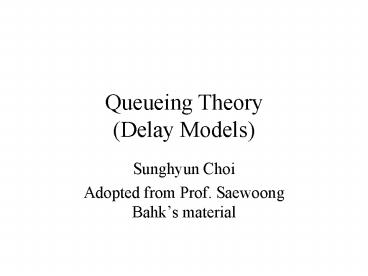Queueing Theory Delay Models - PowerPoint PPT Presentation
1 / 13
Title:
Queueing Theory Delay Models
Description:
Birth-death process: Markov chain with integer states in that transitions occur ... Consider a discrete-time Markov chain Xn, Xn 1 ,... The backward transition ... – PowerPoint PPT presentation
Number of Views:62
Avg rating:3.0/5.0
Title: Queueing Theory Delay Models
1
Queueing Theory (Delay Models)
- Sunghyun Choi
- Adopted from Prof. Saewoong Bahks material
2
Time Reversibility - Burkes theorem
- Birth-death process Markov chain with integer
states in that transitions occur only between
neighboring states - Consider a discrete-time Markov chain Xn, Xn1 ,
3
4
- The backward transition probability
- If for all i,j the chain is time
reversible!!!
5
- Properties of the reversed chain (discrete time)
- (P1) Irreducible, aperiodic, the same stationary
distribution as the forward chain - Proof
6
- (P2) If there are pi s.t.
- form a transition prob. matrix, i.e.,
, - then pi is the stationary distribution and
- are the transition prob. of reversed
chain. - Proof
7
- (P3) A chain is time reversible iff
- (P1) (P2) hold even if chain is not time
reversible! - Birth-death process (e.g., M/M/1, M/M/m, etc.)
are time reversible
8
- For irreducible CTMC
- (P1) The same stationary distribution as the
forward chain with - (P3) The forward chain is time reversible iff
- (detailed balance eq.)
9
- (P2) If there are pi s.t. and
- then pi is the stationary distribution and
- are the transition rates of reversed
chain. - Proof
10
time reversible chain
Non-time reversible chain
11
In steady-state, forward and reverse systems are
statistically indistinguishable!
12
- Burkes theorem Consider an M/M/1, M/M/m, M/M/8
system with arrival rate ?. Suppose that the
system starts in steady-state. Then the following
is true - The departure process is Poisson with rate ?.
- At each time t, the number of customers in the
system is independent of the sequence of
departure times prior to t.
13
EX) Two M/M/1 queues in tandem
- - Poisson arrival and exp. service time
- - Assume that the service times of a customer at
1st and 2nd queues are mutually independent and
independent of arrival process.

